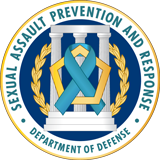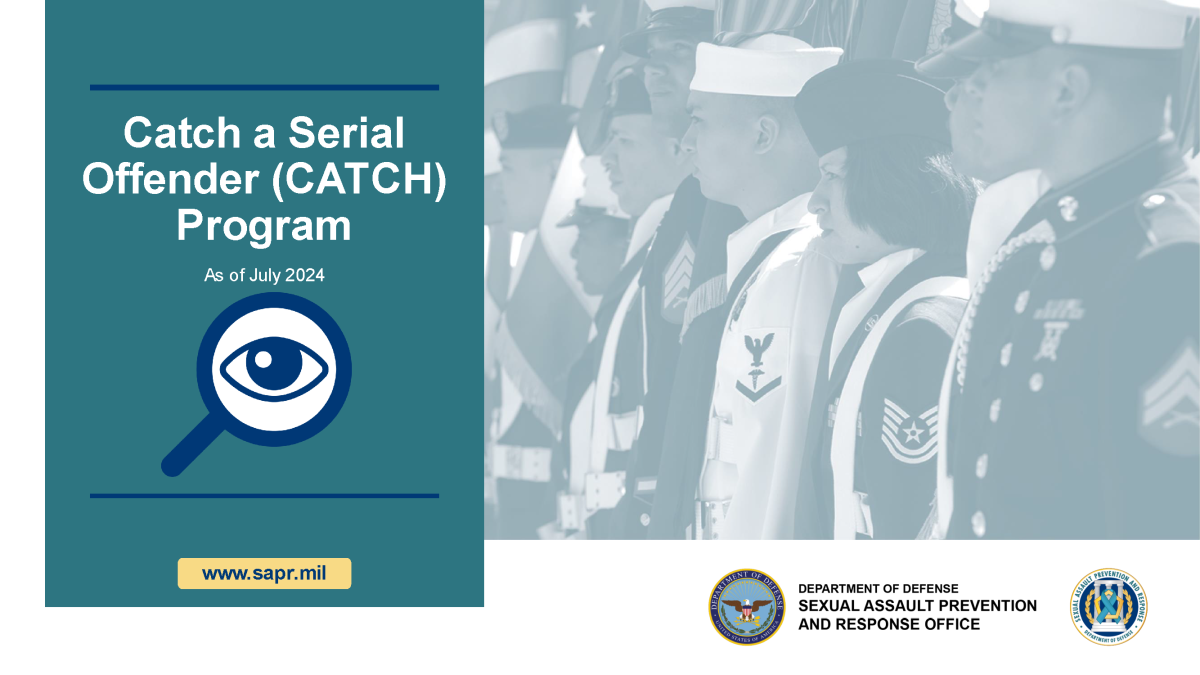Welcome to CATCH!
The CATCH Program gives adult sexual assault victims who filed Restricted Reports, certain Unrestricted Reports where the name of the suspect is not reported to law enforcement or uncovered by law enforcement, or no report an opportunity to anonymously submit suspect information to help the DoD identify serial offenders.
For more information, review the Victim Info Sheet for the CATCH Program and contact your local Sexual Assault Response Coordinator (SARC) or Sexual Assault Prevention and Response (SAPR) Victim Advocate (VA). To locate a SARC or SAPR VA near you, click here.
For general questions about the CATCH Program, contact SAPRO. For CATCH website IT Support, contact 571-305-9999, option 2 (For SARCS only, not victims).
For Victims: |
|||
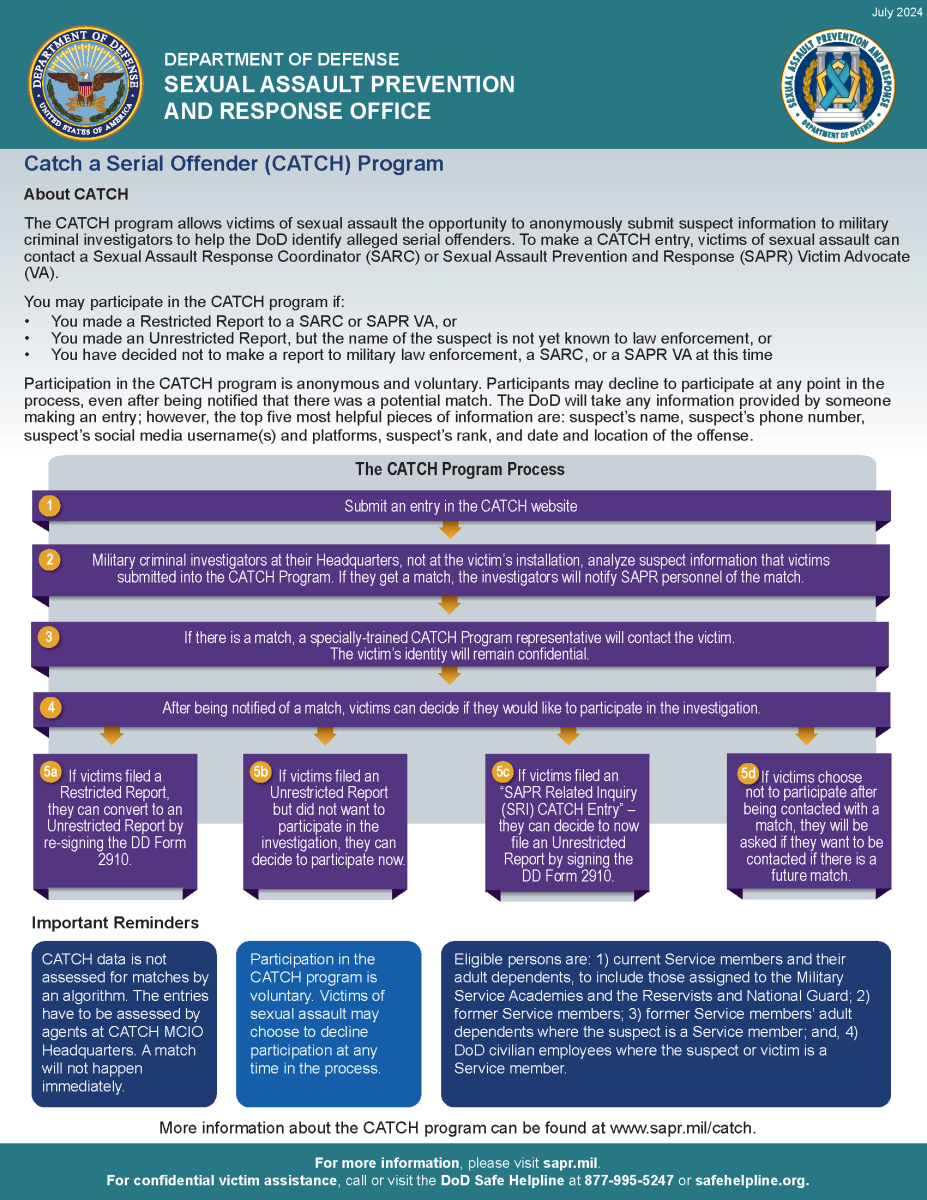 |
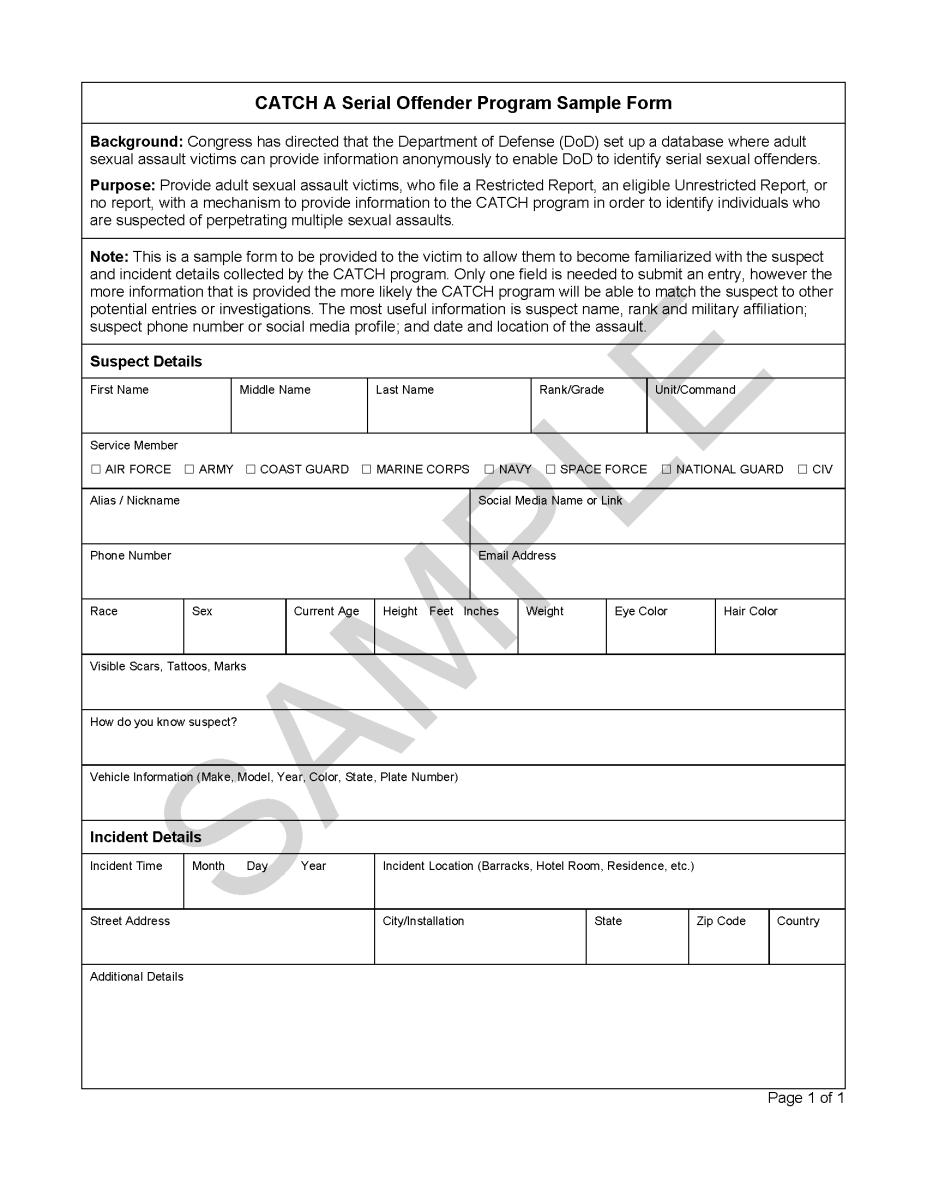 |
||
| Victim Info Sheet for CATCH Program | New CATCH Entry Form | Instructions for Victims Submitting a CATCH Entry | |
| Understand the CATCH program, how it works, and additional resources. | Review a sample CATCH entry form. | Learn how to submit an entry into the CATCH system. A one-page version of the Instructions is available here. | |
For SARCs: |
|||
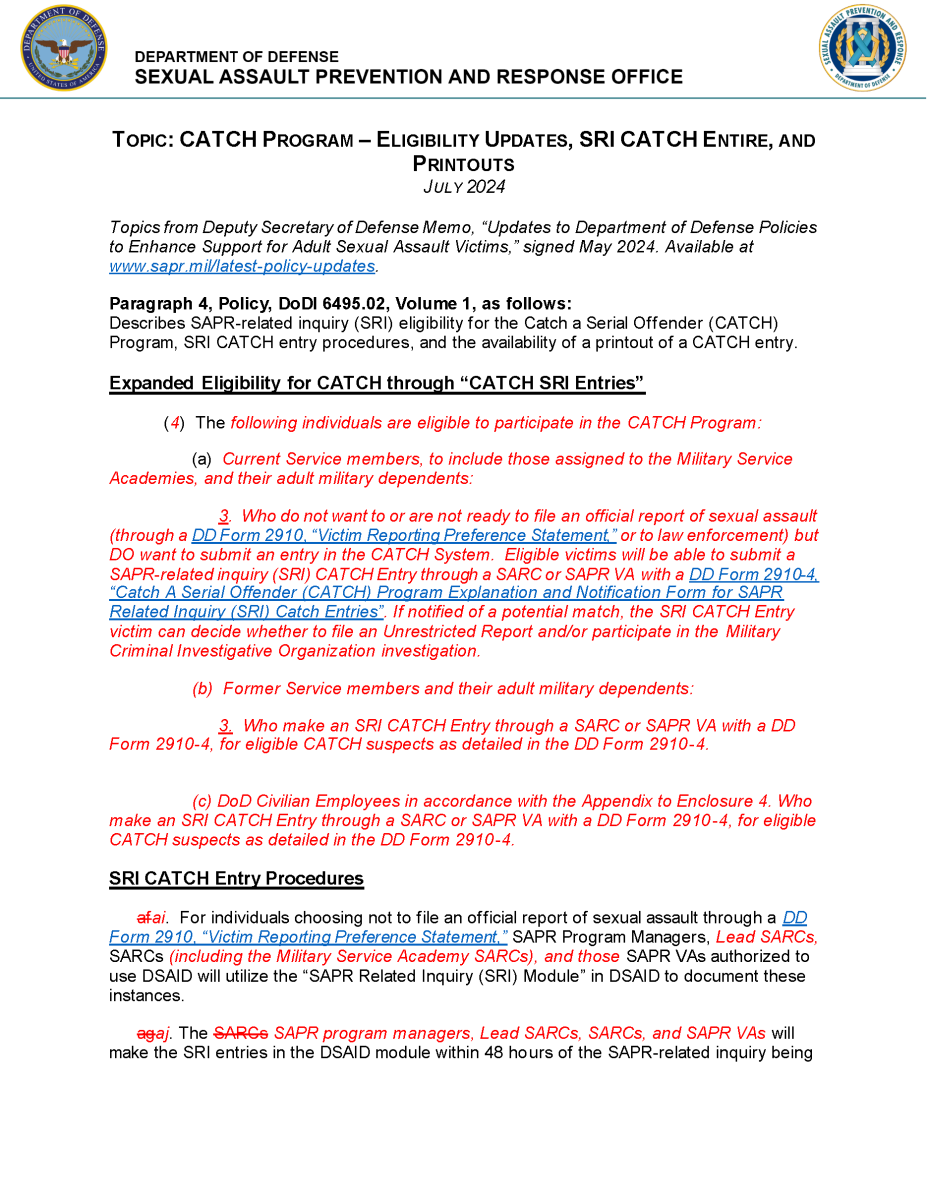 |
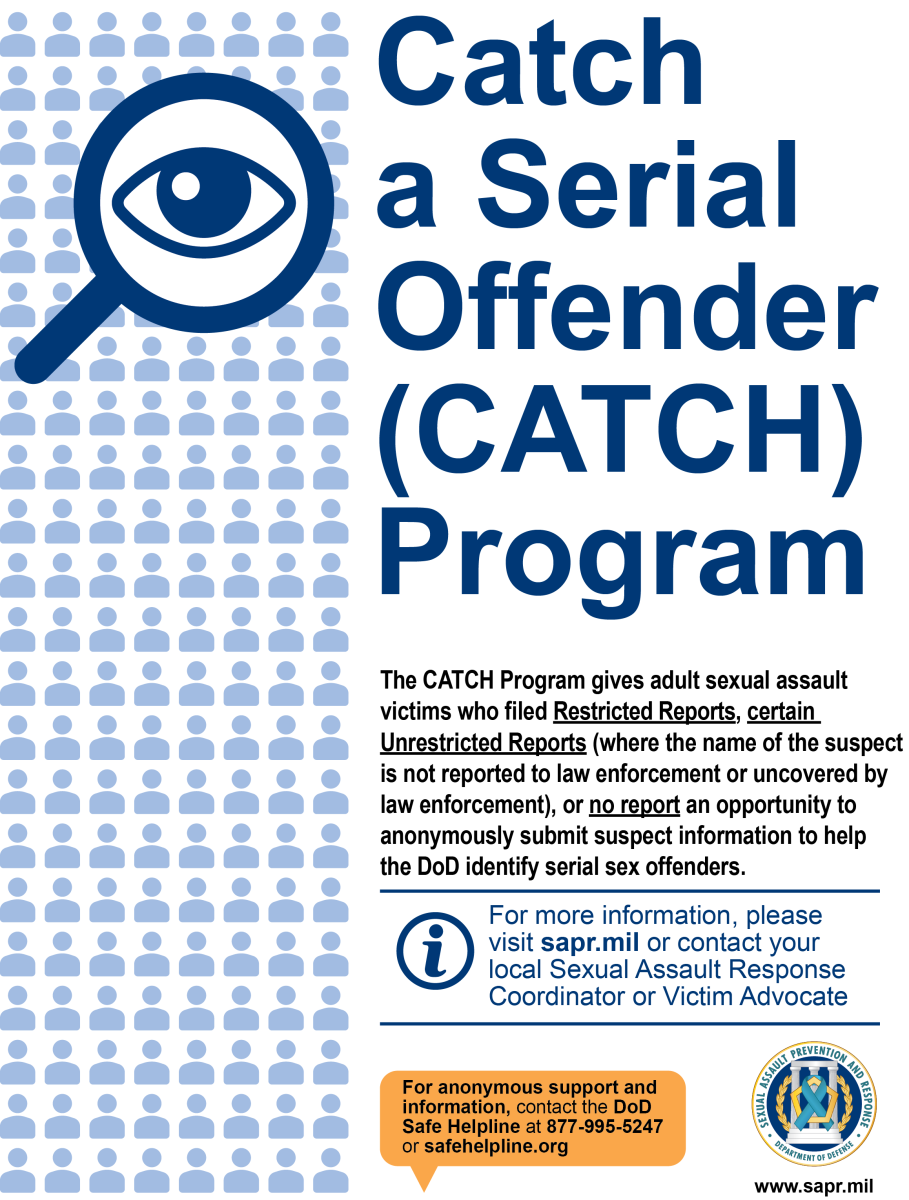 |
||
| Expanded Eligibility to CATCH - Effective July 2024 | CATCH Program Procedures | CATCH Program Poster | CATCH Program Talking Points for SARCs |
| Eligibility extends to adult sexual assault victims who filed Restricted Reports, certain Unrestricted Reports where the name of the suspect is not reported to law enforcement or uncovered by law enforcement, or no report, or made a SAPR Related Inquiry (SRI). | Understand important program information by referencing the CATCH Program Procedures, updated in June 2023. | Promote awareness of the CATCH Program at your installation by printing and posting the CATCH poster. | SARCs and SAPR VAs should use these talking points when explaining the CATCH Program to sexual assault victims and when providing notification to a victim after a match in the CATCH system. |
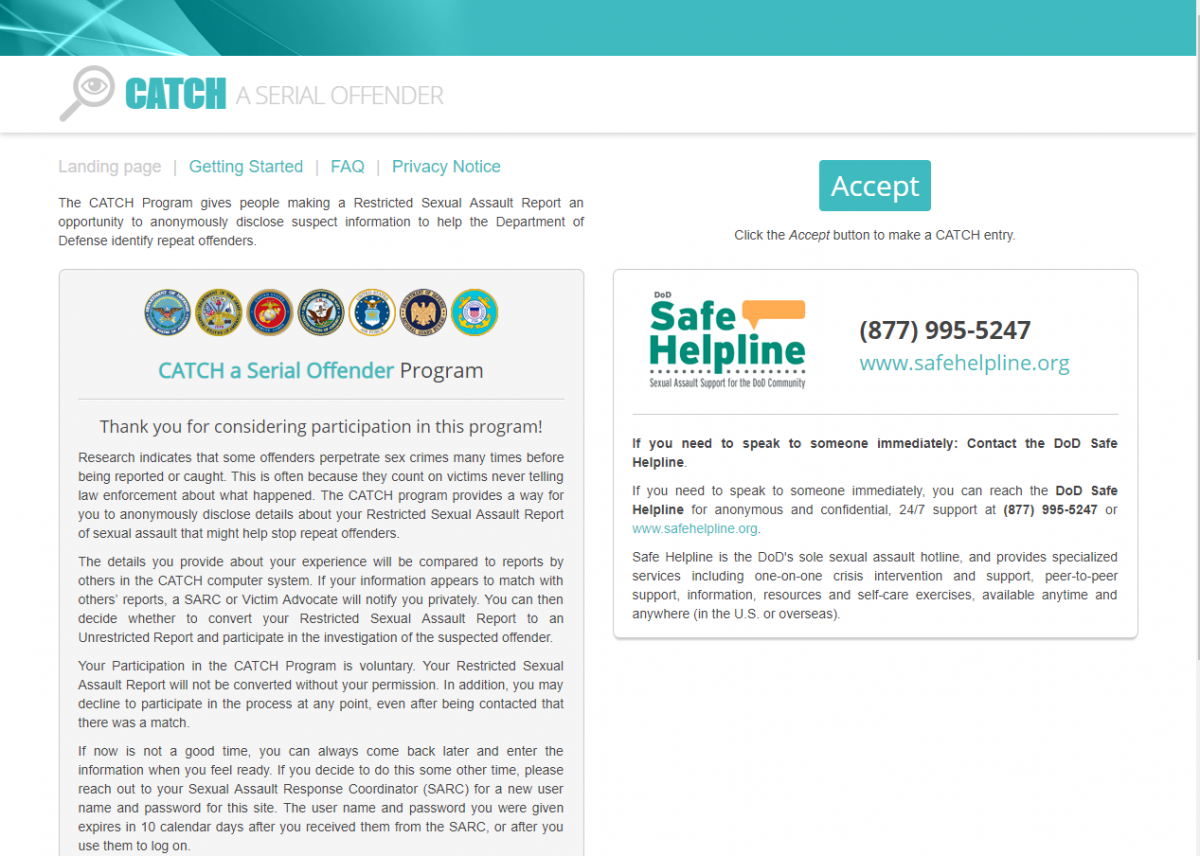 |
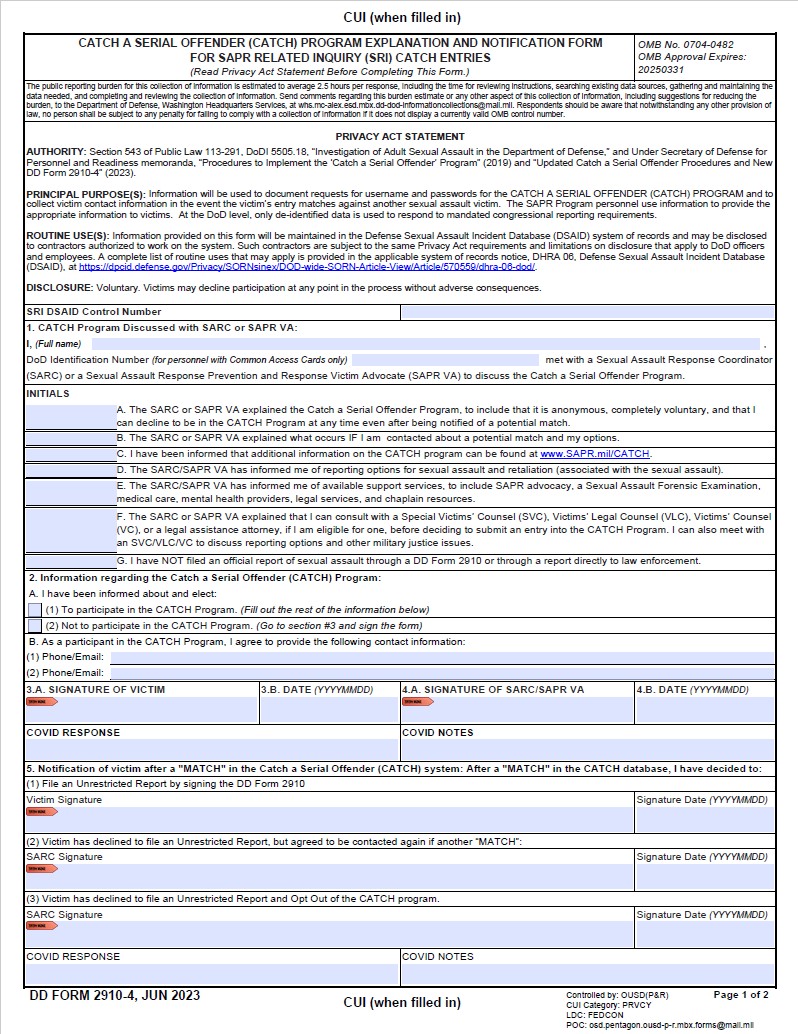 |
||
| Official CATCH Program Website for Victim Entries | DD Form 2910 | DD Form 2910-4 | CATCH Program Introduction Training |
| The official CATCH Program website allows eligible adult sexual assault victims to make an entry using the Username and Password provided by the SARC. | All the CATCH-related information (initial information for victim to submit an entry and documentation of post-match notification) now appears on p.3 of the DD Form 2910. | DD Form 2910-4 is the Catch a Serial Offender (CATCH) Program Explanation and Notification Form For SAPR-Related Inquiry (SRI) CATCH Entries. | This course was designed to bring awareness of the CATCH Program by providing a basic overview and understanding of the program. |
| CATCH 101 | |||
| The Catch 101 is a high-level introduction to the CATCH Program. For more comprehensive instruction, the CATCH JKO Course is coming Fall 2023. |
- How do I make a CATCH entry?
- Visit the CATCH Program website on your computer or mobile device at a time that's convenient. Your SARC can provide you the web address and your personal, anonymous, secure log-in information.
- Do I have to provide my name?
- No, you cannot share your name; the process is anonymous.
- What information do you need about the suspect?
- You can provide as much information as you can remember and feel comfortable sharing (for example, name, rank, height, tattoos or other distinguishing factors), or any other information you think may be important in identifying the suspect, or linking the suspect to other crimes.
- How long do you keep my entry in the CATCH system?
- Each entry is kept for 10 years. This means that you could be contacted at any time over the next 10 years if there is a potential match, as long as you don't opt out and your contact information doesn't change.
- What about my Sexual Assault Forensic Examination (SAFE) Kit?
- The SAFE Kit corresponding to your Restricted Report will be retained for 10 years in order to avoid the unintended destruction of a Restricted Reporting SAFE Kit affiliated with a CATCH entry.
- How will I be contacted if there is a potential match?
- You will be contacted privately, using ONLY the information you provided. Your name and information will remain anonymous until you decide to participate in an investigation and convert your Restricted Report to Unrestricted. You can always say you don't want to participate.
- What if I change my mind, can I opt out of the CATCH Program once I've made my entry?
- Yes, you can opt out at any time - just tell your SARC.
- If a victim who previously filed a Restricted Report hears about the CATCH Program and now wants to submit a CATCH entry, do they have to fill out a new DD Form 2910 with the CATCH notifications and victim's contact information? (See highlighted areas in the attached 2910 to see where the new CATCH information is located)
- Yes, but the victim does not need to fill out a new 2910 in its entirety.
Step 1: The SARC should retrieve the original 2910 to obtain the DSAID Control Number.
Step 2: That DSAID Control number should then be placed on the new 2910 form, but the victim ONLY needs to fill out the CATCH-related questions on the new form and sign it. The rest of the 2910 is left blank.
Step 3: The SARC should then scan in both the old and new 2910s together and upload them into the DSAID File Locker. - If a victim uses their own computer to enter information in the CATCH system, is their IP address captured?
- The CATCH database is a secure database and does not capture IP addresses.
- What if a victim inadvertently provides information in the CATCH database that makes them identifiable (i.e., says the offender is their supervisor and provides the name of the supervisor on the form)? Will they have to convert to an Unrestricted Report?
- A CATCH participant will only convert to an Unrestricted Report by electing to convert their case.
- Who will the other CATCH Program POCs be? Victims may want to know who is going to see their entries.
- Information contained in the database is visible only to specially-designated MCIOs assigned to CATCH headquarters by each Service. There is no identifying information contained in the database to match an entry to the victim.
- If a victim has elected the Unrestricted Reporting option, but does not wish to participate in the investigation, are they able to provide information via the CATCH database?
- No. Only those victims that elect the Restricted Reporting option are eligible to participate in the CATCH Program. However, all CATCH entries are run against open and closed Unrestricted Reports.
- Can a victim of sexual assault who has left the Service still participate in the CATCH Program?
- Victims who are eligible to participate in the CATCH Program are adult sexual assault victims (i.e., Service members, Military Service Academy cadets and midshipmen, and their adult dependents) who have filed a Restricted Report. Former Service members and their adult dependents who filed a Restricted Report while in the service are also eligible for the CATCH Program.
- Can a victim who receives VA benefits for military sexual trauma report their assault in CATCH?
- If the veteran receiving MST benefits made a Restricted Report during their military service, they may contact any SARC from their Military Branch to ask about participating in CATCH. To locate the nearest SARC, click here. If the veteran did not make a Restricted Report while in the Service, Department policy does not currently allow them to make a Restricted Report. Retirees and separated members may only make an Unrestricted Report at this time.
- What are the requirements for a victim who wants to mail in a hardcopy of their CATCH form?
- To do this, the SARC should print out an official form with a serial number for the victim to fill in and provide them with the CATCH Program headquarters mailing address. The SARC should make sure that if a victim wants to mail in a form, they are given the official form with the Victim Report Number on it.
- What happens when a person who participated in CATCH transfers?
- There is no change. If there is a match, the victim will be contacted by the CATCH POC designated by their Service.
- If a victim transfers and signs the DD Form 2910 agreeing to transfer their case, is there a place on the DD Form 2910 to update contact information for CATCH notification purposes?
- When filing a CATCH entry, the victim is asked to provide permanent contact information, as a match may occur in the future, after which they may have transferred or even left the military.
- What should a SARC do if they have an issue with their account and can’t access their username and password?
- If SARCs have problems accessing their accounts their first action should to reach out to their administrator to see if their account is in an "inactive" status. Between 31 to 44 days the accounts go inactive but can be reactivated by an Admin. At the 45-day mark accounts are disabled and an IT ticket will need to be submitted to NCIS headquarters to have the account re-established. This ticket or call must come from the Service SAPR Program Manager or Service CATCH Admin and must include the user’s first name, last name, role, Service, and your DoD ID number located on the back of your CAC. For other CATCH IT issues, call NCIS IT support: 571-305-9999, option 2 (Important: This line is for SARCs only and not intended for victims. It may be answered by law enforcement and could compromise a Restricted Report.)
- What is the role of a Special Victims’ Counsel if there is a match in the CATCH system?
- The Special Victims’ Counsel/Victims’ Legal Counsel (SVC/VLC) will assist the victim in getting answers to questions related to the investigation or legal process.
- What are the requirements for a victim who wants to submit a photo?
- Victims can upload digital photos in the CATCH system with an entry.
- If a victim who previously filed a Restricted Report hears about the CATCH Program and now wants to submit a CATCH entry, do they need to fill out a new DD Form 2910 with the CATCH notifications and victim's contact info?
- Answer: Yes, but the victim does not need to fill out a new 2910 in its entirety.
Step 1: The SARC should retrieve the original 2910 to obtain the DSAID Control Number.
Step 2: That DSAID Control number should then be placed on the new 2910 form, but the victim ONLY needs to fill out the CATCH-related questions on the new form and sign it. The rest of the 2910 is left blank.
Step 3: The SARC should then scan in both the old and new 2910s together and upload them into the DSAID File Locker. - I have more questions. Who can I speak with before deciding?
- If you are eligible, your SARC or SAPR Victim Advocate can offer you a referral to a Special Victims' Counsel (Army, Air Force, National Guard) or Victims' Legal Counsel (Navy, USMC), who is your personal attorney (not a prosecutor or a defense attorney). They can help answer your legal questions about the CATCH program.
- Does a victim always have to file an official report of sexual assault before submitting a CATCH entry?
- No, a victim can make a SAPR-related inquiry (SRI) CATCH entry through a SARC or SAPR VA with a DD Form 2910-4, “Catch A Serial Offender (CATCH) Program Explanation and Notification Form for SAPR Related Inquiry (SRI) Catch Entries,” for eligible CATCH suspects, as detailed in the DD Form 2910-4.
Limiting access to those who do file a formal Restricted or Unrestricted Report significantly restricts the pool of victims who are able to determine whether they were assaulted by a serial offender. Consequently, in order to implement Independent Review Commission on Sexual Assault in the Military (IRC) Recommendation 4.2.c, eligible adult sexual assault victims will be able to submit a CATCH entry without first having to file an official report of sexual assault through the DD Form 2910, “Victim Reporting Preference Statement.”
This will be accomplished through an SRI CATCH entry and the filing of a DD Form 2910-4, “Catch A Serial Offender (CATCH) Program Explanation and Notification Form for SAPR Related Inquiry (SRI) Catch Entries.”
- Can a victim file a sexual assault report with a DD Form 2910-4, “Catch A Serial Offender (CATCH) Program Explanation and Notification Form for SAPR Related Inquiry (SRI) Catch Entries”?
- No, the DD Form 2910-4 was specifically designed for those victims who do NOT wish to file an official report of sexual assault with a SARC but DO want to submit a CATCH entry.
The purpose of the DD Form 2910-4 is to facilitate the submission of a CATCH entry in the CATCH website and to collect the victim’s contact information to be able to contact the victim should there be a future “match” in the CATCH website. The 2910-4 is encrypted and uploaded to the DSAID File Locker for storage purposes only, not to be counted as a sexual assault report.
The only ways to file an official report of sexual assault is by signing a DD Form 2910, “Victim Reporting Preference Statement,” or by providing a victim statement directly to law enforcement.
- Updated eligibility states “when the systems are operational, current and former Service members can ask a SARC or SAPR VA to submit a CATCH Entry, without having to file a report through a DD Form 2910.” If a former Service member files a DD Form 2910-4/SRI CATCH entry and a potential match is identified and the victim wishes to file an Unrestricted Report through a DD Form 2910, what services and support are they eligible to receive? Who does the investigation?
- As of June 30, 2023, everything is now operational in the CATCH system and in DSAID.
The Services and the National Guard Bureau (NGB) will establish their own procedures to determine eligibility for services (advocacy or SVC/VLC/VC), if any, for CATCH victims no longer on Title 10 orders.
The investigative jurisdiction will be determined using the same criteria that is used for non-CATCH investigations. The victim is not eligible to file an Unrestricted Report with a DD Form 2910, but instead will participate directly with the military criminal investigative organization (MCIO)/civilian law enforcement by providing a victim statement.
- If a former Service member did file a Restricted or Unrestricted Report on a DD Form 2910 but at that time did not participate in the CATCH program then changed their mind after they have exited the military, do they now file the DD Form 2910-4 and submit a SRI CATCH entry?
- No, the SARC will:
1. Update the original DD Form 2910 to annotate that the victim wants to participate in CATCH and will collect the victim’s contact information. The SARC will add page 3 to the old form (page 3 of the current DD Form 2910 contains the CATCH information) and upload to DSAID. The SARC will upload the additional information to the original DD Form 2910 for document retention under the original DSAID number. Do NOT substitute the forms and do NOT have the victim fill out a new DD Form 2910, you will upload the addition CATCH paperwork to the already-uploaded DD Form 2910.
2. Use the DSAID number from the original DD Form 2910 to generate a CATCH username and password in the CATCH system.
- If someone wants to submit a CATCH entry through the SRI and there is not a collection of any PII (name/ID #), what is the plan to confirm a case is not matching to themselves if they file at another location?
- Initially it is important to understand that there has to be victim contact information collected on the DD Form 2910-4 in order to later contact a victim, should there be a match. Secondly, the victim should not be filing another CATCH entry on the same subject for the same incident. If they do, and the same info is provided, they will likely match against themselves. CATCH would not be able to distinguish that the two entries are from the same person.
DoD SAPRO recently updated the DD Form 2910 and the DD Form 2910-4, with a *new* question that will ask a victim to confirm that they did not previously submit a CATCH entry on this same suspect for this same sexual assault. SARCs need to ensure that they confirm this with the victim to avoid duplicate entries resulting in the victim matching against themselves.
- If a victim fills out the DD Form 2910-4, but indicates on Question 2.a.2 that they decline to do the CATCH program, what happens with the DD Form 2910-4? Is it uploaded to DSAID?
- If it is signed, then it has to be uploaded to DSAID. Once the DD Form 2910-4 is filled out and signed by the victim, it is immediately encrypted and uploaded into the DSAID File Locker, where it is retained for 50 years. Immediately uploading the DD Form 2910-4 to DSAID is a policy requirement and the upload capability in the DSAID SRI module has been operational since June 30, 2023.
- If after hearing about the CATCH program the victim doesn’t want to submit a CATCH entry and does not sign the DD Form 2910-4, what does the SARC do in DSAID?
- If the victim does not sign the DD Form 2910-4, then the form is never uploaded to DSAID. Just like an unsigned DD Form 2910 is never uploaded to DSAID. The SARC can document the conversation in DSAID using a regular, non-CATCH SRI.
- If the SARC is still generating the SRI but the victim does not sign a DD Form 2910-4, how is that going to affect the quality control/errors report in DSAID? If there is no DD Form 2910-4 uploaded in the system, will a memorandum for record be required for upload under that specific SRI so no error is generated?
- The DD Form 2910-4 is not currently a required field in the SRI DSAID module so there would not be any errors in the example above.
- Once the signed DD Form 2910-4 is uploaded into DSAID under the SRI tab, what is done with the original hard copy of the DD Form 2910-4? Is it maintained under double lock and key?
- Follow established procedures for the storage of DoD forms pursuant to Service/NGB regulations regarding the storage of documents with PII and ensure that all Federal and Service privacy regulations are adhered to.
- If a victim completes the DD Form 2910-4/SRI CATCH process, they are notified of a match, but they do not want to participate in the investigation, but the victim decides they now what to file a Restricted Report through a DD Form 2910. Does the SARC have to change the SRI DSAID Control Number on the previous DD Form 2910-4 to reflect the new Restricted Report DSAID Control Number on the DD Form 2910?
- No, the SRI DSAID Control Number is never updated. The Restricted Report DSAID Control Number and the SRI DSAID Control Number are not linked in DSAID.
If there is a match and the victim does not want to participate in the investigation, ask the victim if s/he wishes to remain in the CATCH system and potentially be contacted again if there is a future match. Based on the victim’s answers, make the required annotations in the CATCH system and in the DD Form 2910-4.
Then, if the victim wishes to file a Restricted Report, have the victim fill out the DD Form 2910 following the regular procedures. There is no need to submit an additional CATCH entry since the SRI CATCH entry remains in the system for 10 years, as long as the victim did not opt out of the CATCH program.
- How is the process anonymous if we are asking the victim for their name and DoD ID number (CAC #) on the DD Form 2910-4?
- The entry that is submitted into the CATCH system is anonymous because there is nothing in the CATCH system that could identify a victim. Consequently, the CATCH Headquarters MCIOs that assess the CATCH entries could never identify a victim.
We do, however, need to have the victim’s contact information to be able to contact the victim if there is a match, but that victim contact information is only on the DD Form 2910-4, which is encrypted and uploaded to the DSAID File Locker.
- If the victim refuses to provide name and DoD ID number (CAC #) on the DD Form 2910-4, what steps should be taken?
- An SRI CATCH Entry can only be submitted if the victim provides contact information, so they could be contacted in the event that there is a future match. That is the way that the CATCH Program works. The CATCH Program is not a whistleblower hotline where people can anonymously submit info on a suspect and never be contacted again. If the victims do not want to submit their names, the SARC needs to try to ascertain the reason why the victim is reluctant. The SARC should explain that the entry that is submitted into the CATCH system is anonymous because there is nothing in the CATCH system that could identify a victim. Consequently, the CATCH Headquarters MCIOs that assess the CATCH entries could never identify a victim. We do, however, need to have the victim’s contact information to be able to contact the victim if there is a match, but that victim’s contact information is only on the DD Form 2910-4, which is encrypted and uploaded to the DSAID File Locker.
If they still do not want to provide their contact information, the SARC should explain what other SAPR services available to the victim and tell the victim that if they ever change their mind, they can always come back and submit a CATCH entry. The SARC should also offer the services of an SVC/VLC, who can assist the victim.
- Can a DoD civilian employee (not a Service member, spouse, adult dependent, or former Service member) submit an SRI CATCH entry through a DD Form 2910-4?
- Not under the current policy. There is a new Deputy Secretary of Defense Memo set to be released in Fall 2023 that may address that issue.
- FAQ SCENARIO: A former Service member or Veteran comes in and wants to submit a CATCH entry. The former Service member never filed a DD Form 2910 while in the Service and now submits an SRI CATCH entry via the DD Form 2910-4 and is then notified of a match and wants to participate in the investigation.
-
1. Does the former Service member have to file an Unrestricted Report through a DD Form 2910? No, the former Service member is not eligible to file a DD Form 2910 but will participate directly with the MCIO by providing a Victim Statement.2. Does the former Service member receive the SAPR services of a SARC? The Services and the NGB will establish their own procedures to determine eligibility for services (advocacy or SVC/VLC/VC), if any, for CATCH victims no longer on Title 10 orders.
